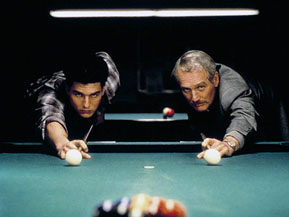|
|
Chapter Two: The Color of MoneyBy Brett BeachMay 12, 2011
If pool shark Fast Eddie Felson isn’t the defining role for Paul Newman - I would actually accord that honor to his seriocomedic portrait of washed up hockey player/coach Reggie Dunlop in Slap Shot - it provides an apt encapsulation of the blend of heartbreaking gorgeousness, cocky attitude, stubborn demeanor, and wounded pride that marked his career. Coming on the heels of his first nomination (for Cat on a Hot Tin Roof in 1959), his role in The Hustler kicked off a decade that would see him play titular characters as memorable as Hud, Cool Hand Luke, Lew Harper, and Butch Cassidy, and get additional nominations for the first two of those performances. Fifty years after its release, The Hustler still strikes me as one of the more unconventional Best Picture nominees of all time. Yes, it’s in black and white and is an adaptation of an acclaimed novel, but it feels so otherworldly in certain moments that it doesn’t quite fit the requirements of “Oscar bait” and moves at such a deliberate pace and with such a hushed and muted tone for much of its 135 minute length that it certainly doesn’t qualify as a crowd pleaser, and yet it succeeded on both counts in 1961. The key dramatic moment - a marathon pool session between Felson and legendary player Minnesota Fats - has passed with barely the half hour mark cracked and what follows, even with more than a few twists of the plot thrown in, feels like epilogue in a way.
|

|
|
|

|
Friday, November 1, 2024
© 2024 Box Office Prophets, a division of One Of Us, Inc.


